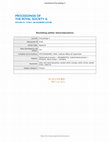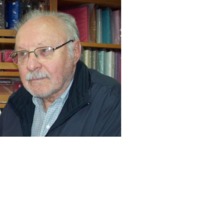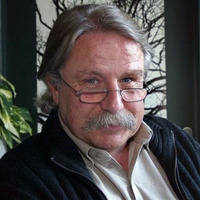Videos by ihor kotchergenko
Aplies the Areolar Strain Concept*,whitch is realy the planar gradient of the vector field of dis... more Aplies the Areolar Strain Concept*,whitch is realy the planar gradient of the vector field of displacements.
(*) Solids, Structures and Fluids, Vol. 12 ASME 2008 1 views
Applies the Areolar Strain Concept* to develop a new plane theory of elasticity.
(*) The Areola... more Applies the Areolar Strain Concept* to develop a new plane theory of elasticity.
(*) The Areolar Strain Concept, Solids, Structures and Fluids, Vol. 12 ASME 2008 2 views
Applies the Areolar Strain Concept* to present a plate equation for medium thickness defining ... more Applies the Areolar Strain Concept* to present a plate equation for medium thickness defining the benging and shear rigidities.
https://www.youtube.com/watch?v=Wun6Vqmb9FQ
(*) The Areolar Strain Concept, Solids, Structures and Fluids,
Vol. 12, ASME 2008 25 views
Uses the areolar strain concept(*), to define a compatible field of displacements in the vicinity... more Uses the areolar strain concept(*), to define a compatible field of displacements in the vicinity of the neutral plane of the plate.
Defines the bending rigidity with the bi-harmonic part and the shear rigidity with the tri-harmonic part of the equilibrium equation. Aplications of the Areolar Theory of Elasticity
Applications of the Areolar Theory of Elasticity
1 views
Papers by ihor kotchergenko
A narrated video presenting a new approach to the plane theory of elasticity..
The areolar strain... more A narrated video presenting a new approach to the plane theory of elasticity..
The areolar strain concept was presented at several instances as it can be seen in the bibliography presented. It is based on the practically unknown Riemann's derivative associated with Kolosov's derivatives.
Several applications are presented to show the power of this approach.
The fundamental equations of the isotropic and anisotropic plane theory of elasticity are reworke... more The fundamental equations of the isotropic and anisotropic plane theory of elasticity are reworked in the frame of the generalized analytic functions theory. The strain, compatibility and equilibrium equations are rewritten in that frame, and a general solution for the isotropic case, is obtained in a fairly straightforward fashion. Polynomial expansions of the displacement field which are suitable for finite elements modeling of isotropic and anisotropic planes and that retains rotational degrees of freedom, are also presented.
https://www.youtube.com/watch?v=Wun6Vqmb9FQ, 2020
Applies the Areolar Strain Concept*
(*) The Areolar Strain Concept, "Solids , Structures and F... more Applies the Areolar Strain Concept*
(*) The Areolar Strain Concept, "Solids , Structures and Fluids", Vol. 12 ASME 2008
CMM-Computer Methods in Mechanics, ,Polish Academy of Sciencess, 2005
The fundamental equations of the isotropic and anisotropic plane theory of elasticity are reworke... more The fundamental equations of the isotropic and anisotropic plane theory of elasticity are reworked in the frame of the generalized analytic functions theory. The strain, compatibility and equilibrium equations are rewritten in that frame, and a general solution for the isotropic case, is obtained in a fairly straightforward fashion. Polynomial expansions of the displacement field which are suitable for finite elements modeling of isotropic and anisotropic planes and that retains rotational degrees of freedom, are also presented.
Revista da Escola de Engenharia da UFMG
We propose to extend the transfer matrix method, presented by Rjanitzen [1], aiming to solve the ... more We propose to extend the transfer matrix method, presented by Rjanitzen [1], aiming to solve the problem of buckling of continuous solid bars, to the problem of buckling by bending and concurrent twisting of open cross section thin-walled straight bars, supported on several elastic or rigid links. We will follow the theory presented at Chap. V. from Vlazov's book [3].
The power flow of irrotational elastic waves is presented by several authors but the same does no... more The power flow of irrotational elastic waves is presented by several authors but the same does not occurs with regard to the power flow of equivoluminal waves. These authors are unanimous that the shearing strain alone is not sufficient for calculating the energy flux of an equivoluminal elastic wave and that it is necessary to consider the small rotation as well. In the areolar strain concept the rotation is naturally included into the definition of strain. This fact allows a direct calculation of the power flow of pure shear waves.
Teaching Documents by ihor kotchergenko
Narrated Presentation of thrplane elasticity based on Riemann's derivative.
The strain is obtaine... more Narrated Presentation of thrplane elasticity based on Riemann's derivative.
The strain is obtained as the gradient of the displacement vector field in the form of four orthogonal two-dimensional functions.
Applications are also presented to demonstrate the power of this new method.
Youtube course with images and speech proposing a new approch to the plane theory of elasticity,... more Youtube course with images and speech proposing a new approch to the plane theory of elasticity, based entirelly on the generalized comples variables theory.
The gradient a plane vector field is defined in terms of a group o four orthogonal two-dimensional functions.
Drafts by ihor kotchergenko

REVISITING AETHER ELECTRODYNAMICS
At ICM 2018-International Conference of Mathematicians the writer presented a poster showing that... more At ICM 2018-International Conference of Mathematicians the writer presented a poster showing that shear waves perform a deformation that combines harmonic transversal displacements and rotations. Each wavelength presents two rotations in opposite directions. Whittaker in his book “A History of the Theories of Aether and Electricity” says that Maxwell expressed that “induced me to regard magnetism as a phenomenon of rotation and electric currents as phenomena of translation”. The writer shows precisely this, applying the areolar theory of elasticity, which enables expressing both shear and displacements through rotations only. The writer hopes that this theory will provide aids for new experiments and deeper interpretation of electromagnetic phenomena. Several results for elastic shear waves in solids are available and may be useful. A presentation of the areolar theory of elasticity, witch is behind the exposition is included for completeness. The writer recommends that the reader start reading section 3, which presents the electromagnetic model, and for details of the mathematics involved, read from beginning.

Revisiting Aether Electrodynamics
At ICM 2018-International Conference of Mathematicians the writer presented a poster showing that... more At ICM 2018-International Conference of Mathematicians the writer presented a poster showing that shear waves perform a deformation that combines harmonic transversal displacements and rotations. Each wavelength presents two rotations in opposite directions. Whittaker in his book “A History of the Theories of Aether and Electricity” says that Maxwell expressed that “induced me to regard magnetism as a phenomenon of rotation and electric currents as phenomena of translation”. The writer shows precisely this, applying the areolar theory of elasticity, which enables expressing both shear and displacements through rotations only. The writer hopes that this theory will provide aids for new experiments and deeper interpretation of electromagnetic phenomena. Several results for elastic shear waves in solids are available and may be useful. A presentation of the areolar theory of elasticity, witch is behind the exposition is included for completeness. The writer recommends that the reader start reading section 3, which presents the electromagnetic model, and for details of the mathematics involved, read from beginning.

Proceedings of the Royal Society A, 2021
At ICM 2018-International Conference of Mathematicians the writer presented a poster showing that... more At ICM 2018-International Conference of Mathematicians the writer presented a poster showing that shear waves perform a deformation that combines harmonic transversal displacements and rotations. Each wavelength presents two rotations in opposite directions. Whittaker in his book “A History of the Theories of Aether and Electricity” says that Maxwell expressed that “induced me to regard magnetism as a phenomenon of rotation and electric currents as phenomena of translation”. The writer shows precisely this, applying the areolar theory of elasticity, which enables expressing both shear and displacements through rotations only. The writer hopes that this theory will provide aids for new experiments and deeper interpretation of electromagnetic phenomena. Several results for elastic shear waves in solids are available and may be useful. A presentation of the areolar theory of elasticity, witch is behind the exposition is included for completeness. The writer recommends that the reader start reading section 3, which presents the electromagnetic model, and for details of the mathematics involved, read from beginning.

PROCEDINGS OF THR ROYAL SOCIETY a
At ICM 2018-International Conference of Mathematicians the writer presented a poster showing that... more At ICM 2018-International Conference of Mathematicians the writer presented a poster showing that shear waves perform a deformation that combines harmonic transversal displacements and rotations. Each wavelength presents two rotations in opposite directions. Whittaker in his book “A History of the Theories of Aether and Electricity” says that Maxwell expressed that “induced me to regard magnetism as a phenomenon of rotation and electric currents as phenomena of translation”. The writer shows precisely this, applying the areolar theory of elasticity, which enables expressing both shear and displacements through rotations only. The writer hopes that this theory will provide aids for new experiments and deeper interpretation of electromagnetic phenomena. Several results for elastic shear waves in solids are available and may be useful. A presentation of the areolar theory of elasticity, witch is behind the exposition is included for completeness. The writer recommends that the reader start reading section 3, which presents the electromagnetic model, and for details of the mathematics involved, read from beginning.






Uploads
Videos by ihor kotchergenko
(*) Solids, Structures and Fluids, Vol. 12 ASME 2008
(*) The Areolar Strain Concept, Solids, Structures and Fluids, Vol. 12 ASME 2008
https://www.youtube.com/watch?v=Wun6Vqmb9FQ
(*) The Areolar Strain Concept, Solids, Structures and Fluids,
Vol. 12, ASME 2008
Defines the bending rigidity with the bi-harmonic part and the shear rigidity with the tri-harmonic part of the equilibrium equation.
Papers by ihor kotchergenko
The areolar strain concept was presented at several instances as it can be seen in the bibliography presented. It is based on the practically unknown Riemann's derivative associated with Kolosov's derivatives.
Several applications are presented to show the power of this approach.
(*) The Areolar Strain Concept, "Solids , Structures and Fluids", Vol. 12 ASME 2008
Teaching Documents by ihor kotchergenko
The strain is obtained as the gradient of the displacement vector field in the form of four orthogonal two-dimensional functions.
Applications are also presented to demonstrate the power of this new method.
The gradient a plane vector field is defined in terms of a group o four orthogonal two-dimensional functions.
Drafts by ihor kotchergenko
(*) Solids, Structures and Fluids, Vol. 12 ASME 2008
(*) The Areolar Strain Concept, Solids, Structures and Fluids, Vol. 12 ASME 2008
https://www.youtube.com/watch?v=Wun6Vqmb9FQ
(*) The Areolar Strain Concept, Solids, Structures and Fluids,
Vol. 12, ASME 2008
Defines the bending rigidity with the bi-harmonic part and the shear rigidity with the tri-harmonic part of the equilibrium equation.
The areolar strain concept was presented at several instances as it can be seen in the bibliography presented. It is based on the practically unknown Riemann's derivative associated with Kolosov's derivatives.
Several applications are presented to show the power of this approach.
(*) The Areolar Strain Concept, "Solids , Structures and Fluids", Vol. 12 ASME 2008
The strain is obtained as the gradient of the displacement vector field in the form of four orthogonal two-dimensional functions.
Applications are also presented to demonstrate the power of this new method.
The gradient a plane vector field is defined in terms of a group o four orthogonal two-dimensional functions.
Key words: ether and electrodynamics, areolar strain concept.
This theory is based on the Areolar Strain Concept which defines strain as the Riemann derivative of a plane vector field od any nature.
Several applications are presented to demostrate the power of this new concept.